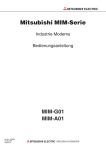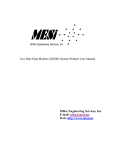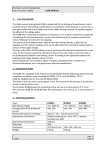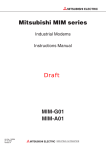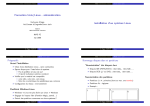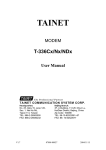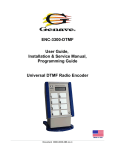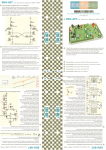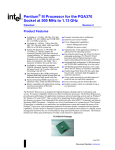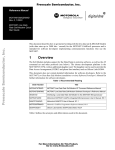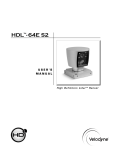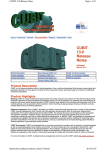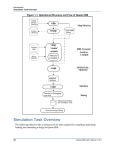Download VSIM Modem and Telephony Simulator User Manual
Transcript
VSIM Modem and Telephony Simulator User Manual Miller Engineering Services, Inc. E-mail: [email protected] Web: www.mesi.net 1 VSIM USAGE....................................................................................................................................... 3 1.1 VSIM COMMAND LINE OPTIONS .................................................................................................... 3 1.1.1 -v Option................................................................................................................................. 4 1.1.2 -f[filename] Option................................................................................................................. 5 1.1.3 -o[filename] Option................................................................................................................ 5 1.1.4 -D[filename] Option ............................................................................................................... 6 1.1.5 -NUM[samples] ...................................................................................................................... 6 1.1.6 -m[mode], -M[mode] Options ................................................................................................ 6 1.1.7 -n[ratio] Option...................................................................................................................... 6 1.1.8 -t[power] Option..................................................................................................................... 6 1.1.9 -twist[ratio] Option ................................................................................................................ 6 1.1.10 -T[ratio] Option...................................................................................................................... 6 1.1.11 -r[rate] Option........................................................................................................................ 7 1.1.12 -c[filename] Option ................................................................................................................ 7 1.1.13 -i[type] Option........................................................................................................................ 7 1.1.14 -d[dir] Option ....................................................................................................................... 12 1.1.15 -p Option............................................................................................................................... 12 1.1.16 -w Option .............................................................................................................................. 12 1.1.17 -l[delay] Option.................................................................................................................... 12 1.1.18 -g[level], -G[level] Options.................................................................................................. 12 1.1.19 -j[freq], -J[level] Options..................................................................................................... 12 1.1.20 -s[offset] Option ................................................................................................................... 12 1.1.21 -BER[filename] Option......................................................................................................... 13 1.1.22 -ACQ Option......................................................................................................................... 13 1.1.23 -L[length] Option ................................................................................................................. 13 1.1.24 -E[length] Option ................................................................................................................. 13 1.1.25 -YA[delay] and YC[delay] Option....................................................................................... 14 1.1.26 -NA[delay] and NC[delay] Option ...................................................................................... 14 1.1.27 -F[delay] Option................................................................................................................... 14 1.1.28 -ERLnearA[gain] Option...................................................................................................... 14 1.1.29 -ERLfarA[gain] Option ........................................................................................................ 15 1.1.30 -ERLnearC[gain] Option...................................................................................................... 15 1.1.31 -ERLfarC[gain] Option ........................................................................................................ 15 1.1.32 -C[type] Option .................................................................................................................... 15 1.1.33 -O[freq][%] Option.............................................................................................................. 16 1.1.34 -h[freq] and -H[ratio]Options.............................................................................................. 16 1.1.35 -S Option............................................................................................................................... 16 1.1.36 -P Option .............................................................................................................................. 16 1.1.37 -EC_plot_taps Option........................................................................................................... 16 1.1.38 -V Option .............................................................................................................................. 17 1.1.39 -IQ Option ............................................................................................................................ 17 1.1.40 -nographics Option............................................................................................................... 17 1.2 VSIM SIMULATION OPTIONS ........................................................................................................ 17 1 VSIM Usage The VSIM simulator runs under a DOS window that switches to full screen to support VGA graphics mode. It is a DOS command-line driven program that accepts a variety of command-line configurations and run-time controls that are described in the following sections. VSIM implements a two-channel telecom simulation that emulates a CALL channel and an Answer channel so that fax and data modems, call progress, dual tone digit signaling, and miscellaneous telephony tones can be evaluated. VSIM can be configured to display and/or dump to file the Answer or CALL side receiver() processor’s operational status, and the user can toggle the display and file mode between CALL and Answer during execution. The channel simulation includes a variety of common telephony impairments that can be selectively enabled at run time and altered during execution. The graphical display is a crude emulation of a 2-channel storage oscilloscope with dual-trace and X-Y plot modes, again selectable at run time and during execution. File I/O includes a general run-time continuous dump in a file called simply “x”, and a time-tagged log of all transmitter() and receiver() state_ID’s for both CALL and Answer sides in a file called “states.dat”. VSIM can optionally accept input for a specified sample file (8 kHz samples, one per line, ASCII HEX format) so that users can digitize live-line signals, feed them to VSIM (which implements exactly the same algorithms as the DSP ports), and readily observe the modem’s behavior off-line. The VSIM channel model provides a complete and accurate method for Bit Error Rate (BER) and Acquisition (ACQ) testing under a variety of impairments in an automated fashion In BER and ACQ modes, the SNR is automatically swept and the BER, BLER (Block Error Rate), and acquisition statistics are logged to “ber.dat”. 1.1 VSIM Command Line Options The general form for execution of the VSIM simulator under MS-DOS is: VSIM –option –option –option … Where the –options are: -v[modem] => modem type: (default is -v29) 8, 17, 17TEP, 21, 22, 23, 23B, 26, 26A, 26B, 26P, 27, 27TEP, 29, 29TEP, 32, 32bis, 34, bell103, bell103F1, bell103F2, bell202, noise, tone, CED, ECSD, DTMF, R1, R2F, R2B, CAS, CID, CNG, dialtone, ringback, busy, reorder -f[filename] => file input -o[filename] => output IF to file, default='rxif.dat' -D[filename] => data file input, ASCII hex, one symbol per line -NUM[samples] => num_samples, frame size (8kHz samples), default=20 -m[mode] => Tx->mode, -M[mode] => Rx->mode -n[ratio] => Signal-to-Noise Ratio (dB), default=100 dB -t[power] => CALL Tx power (dBm0), default=-16 dBm0 -T[ratio] => answer/call Tx power ratio (dB), default=0 dB -twist[ratio] => high/low tone Tx power ratio (dB), default=0 dB -r[rate] => data rate: 1200 through 14400 (bits/sec.), default=9600) -c[filename] => plot constellation or file -i[type] => gain distortion impairment: (default=0) 0=none, 1=AT&T spec, 2=PSTN typical, 3=CONUS_MV, 4=CONUS_PV -d[dir] => direction: a=answer c=call, default=a -p => enable pause between modem calls -w => enables wattmeter -l[delay] => Rx/Tx path delay (8kHz samples), default=0 -g[level] => gain hit level (dB), -G[frequency] => sinusoidal gain mod -j[freq] => phase jitter freq (Hz), -J[level] => jitter level (degrees) -s[offset] => Tx symbol clock offset, default=0 -BER[filename] => measure BER, write results to file, default: ber.dat -ACQ => enable acquisition measurement mode -L[length] => BER burst length (bits), default=1e7 -E[length] => BER errors per SNR level (bits), default=1e7 -YA[delay] => ANS Tx->system_delay (8kHz samples), default=0 -YC[delay] => CALL Tx->system_delay (8kHz samples), default=0 -NA[delay] => ANS near-end path delay (8kHz samples), default=0 -NC[delay] => CALL near-end path delay (8kHz samples), default=0 -F[delay] => Rx/Tx far-end path delay (8kHz samples), default=0 -ERLnearA[gain] => ANS near-end Echo Return Loss (dB), default=0dB -ERLfarA[gain] => ANS far-end Echo Return Loss (dB), default=infinite -ERLnearC[gain] => CALL near-end Echo Return Loss (dB), default=0dB -ERLfarC[gain] => CALL far-end Echo Return Loss (dB), default=infinite -C[type] => write Coefficients to file 'coef.dat', default=disabled 1=C, 2='C3x, 3='C54x, 4=ATT161x, 5=ADSP21xx, 6=ADSP2106x -O[freq] => frequency Offset (Hz), default=0 -h[freq] => hum frequency (Hz), -H[ratio] => signal-to-hum ratio (dB) -S => suppress banner display -P => XY plot persistence (0=accumulate, max=2047) -EC_plot_taps => plot echo canceller taps -V => enable Tx and Rx test vector dump to txvector.dat and rxvector.dat -IQ => enable constellation I and Q dump to iq.dat file -nographics => disable graphics 1.1.1 -v Option The –v option configures the transmitter() for the selected type of signal, and sets up the receiver()’s detector mask as requires to enable detection of the selected signal. The available –v components available are: -v8: ITU-T V.8 modem configured for use in a v.34 connection -v17: ITU-T V.17 fax modem -v17TEP: ITU-T V.17 fax modem with 1800 Hz Talker Echo Protection signal enabled -v21: ITU-T V.21 configured for v.21 data modem -v21hdlc or -v21fax: ITU-T V.21 channel 2 configured for fax HDLC flag transmission and GenDet fax v21 channel 2 HDLC flag detection -v22: ITU-T V.22bis -v23: ITU-T V.23 data modem -v23B ITU-T V.26 75 baud backward channel. -v26: ITU-T v.26 modem operating in the ALT-B configuration transmitting all ones -v26A or –v26B: ITU-T V.26 ALT-A or ALT-B transmitting all ones. -v26P: ITU-T V.26bis, ALT-B transmitting P1800 alternations per FSVS-210 (STU-III mode). -v26fast: ITU-T V.26 ALT-B transmitting all ones, with reduced receiver synchronization time. -v27: ITU-T V.27ter fax modem -v27TEP: ITU-T V.27ter fax modem with 1800 Hz Talker Echo Protection signal enabled -v29: ITU-T V.29 fax modem with 1700 Hz Talker Echo Protection signal enabled -v29TEP: ITU-T V.29 fax modem -v32: ITU-T V.32 without the TCM 9,600 mode -v32bis: ITU-T V.32bis data modem -v34: ITU-T V.34 data modem -vbell103: Bellcore Bell 103 300 baud modem in the F1 channel. -vbell103F1: Bellcore Bell 103 300 baud modem in the F1 channel -vbell103F2: Bellcore Bell 103 300 baud modem in the F2 channel -vbell202: Bellcore Bell 202 FSK modem operating from 300 to 1350 baud -vnoise: Additive White Gaussian Noise (AWGN) only at SNR specified by –nSNR -vtone: single tone oscillator at frequency specified by –Ofrequency -vCED: ITU-T T.30 fax CallED 2100 Hz tone -vECSD: ITU-T V.25 Echo Canceller Suppressor Disable tone, 2100 Hz with 450 msec. phase reversals -vDTMF: ITU-T Discrete Tone Multi-Frequency digits: 0-9, *, #, A,B,C,D -vR1: ITU-T Multi-Frequency R1 signaling digits 0-9, 11, 12, KP, KP2, ST -vR2F: ITU-T Multi-Frequency R2 Forward signaling digits 0-9, A-E -vR2B: ITU-T Multi-Frequency R2 Backward signaling digits 0-9, A-E -vCAS or -vCAS1: ETSI Type 1 Caller ID with preceding CPE Alert Signal -vCID or -vCID1: ETSI Type 1 Caller ID FSK -vCID2: ETSI Type 2 Caller ID for Call Waiting with preceding CPE Alert Signal -vCAS1B: Bellcore Type 1 Caller ID for with preceding CPE Alert Signal -vCID1B: Bellcore Type 1 Caller ID FSK -vCID2B: Bellcore Type 2 Caller ID for Call Waiting with preceding CPE Alert Signal -vCNG: ITU-T T.30 fax CalliNG 1100 Hz tone -vdialtone: ITU-T North American dialtone (350 Hz + 440 Hz tones) -vringback: ITU-T North American ringback (440 Hz + 480 Hz tones, 4 sec. On, 2 sec. off) -vbusy: ITU-T North American busy (480 Hz + 620 Hz tones, 0.5 sec. on, 0.5 sec. off) -vreorder: ITU-T North American reorder or fast-busy (480 Hz + 620 Hz tones, 0.25 sec. on, 0.25 sec. off) 1.1.2 -f[filename] Option The –f option allows the user to read in samples from a file specified by [filename] for processing by the receiver() enabled by the –v option. The file format is 4 characters ASCII HEX samples, one per line, and samples at 8 kHz. The user can generate an example of a suitable file by running VSIM –osamples.dat to produce the file samples.dat in the specified format. Users are advised that full duplex modems will not correctly handshake when using sample files for input because the transmitter()’s signals have been overwritten by the file samples. 1.1.3 -o[filename] Option The –o option allows the user to dump the samples produced by both the CALL and Answer transmitter()s at the point where they are applied to the CALL receiver() if CALL direction is selected, or to the Answer receiver() if the Answer direction is selected. The file format is 4 characters ASCII HEX samples, one per line, and samples at 8 kHz. 1.1.4 -D[filename] Option The –D option allows the user to modulate data from a text file that is formatted as one hex ASCII symbol per line. For example, to modulate symbols using v.29 at 9,600 bits/sec. (4 bits/symbol) from a file called ‘data.dat’, you would run: VSIM –v29 –r9600 –Ddata.dat Where the ‘data.dat’ file might contain hex ASCII symbols: 0 1 e f 1.1.5 -NUM[samples] The –NUM option sets the frame size (num_samples). This is the number of 8kHz samples created in one call to the TX function, and the minimum number of samples processed by one call to the RX function. The RX function will return a zero value without processing samples if at least num_samples samples are not available. The default frame size is 20 samples. 1.1.6 -m[mode], -M[mode] Options The –m and –M mode options modify Tx->mode and Rx->mode respectively. These correspond to the mode definitions presented later in this manual, and are automatically invoked using the –v options above. One exception is that –m8 selects a half-duplex input mode for v32 and v34 so that the half-duplex training signals can be processed using the –f option. 1.1.7 -n[ratio] Option The –n option sets the Signal-to-Noise Ratio and is entered as a floating-point number in dB. The default SNR is 1000 dB (essentially no noise). For example, v.29 at 25 dB SNR would be entered as: VSIM –v29 –n25 1.1.8 -t[power] Option The –t option sets the transmitter power level ratio and is entered as a floating-point number in dBm0. The default transmitter power level is -16 dBm0. For example v.29 at – 28 dBm0 would be entered as: VSIM –v29 –t-28 1.1.9 -twist[ratio] Option The –twist option sets the high/low tone power level ratio and is entered as a floatingpoint number in dB. The default twist is 0 dB. For example DTMF at 8 dB twist would be entered as: VSIM –vdtmf –twist8 1.1.10 -T[ratio] Option The –T option sets the/CALL transmit power ratio and is entered as a floating-point number in dB. The default ratio is 0 dB, which corresponds to both, CALL and Answer transmitter()s operating without attenuation. The channel model takes the value entered, converts it to a linear number, and multiplies the Answer transmitter() samples by this number. Therefore a –T value of –10 would correspond to a scale factor of 10-10/20 applied to the Answer transmitter()’s samples, or an attenuation factor of 0.316. Similarly Therefore a –T value of 10 would correspond to a scale factor of 1010/20 applied to the Answer transmitter()’s samples, or a gain factor of 3.16. Users should note that large positive values for –T might result in excessive gain and saturation of the Answer transmitter() signal. Therefore it is advised to attenuate also using –t. For example, v.32 with a CALL side transmit power of –16 dB and Answer side transmit power of –28 dB would be entered as: VSIM –v29 –T-12 As another example, v.32 with a CALL side transmit power of –28 dB and Answer side transmit power of –10 dB would be entered as: VSIM –v29 –T18 1.1.11 -r[rate] Option The –r option sets the bit rate for the modulator selected and is entered in bits/sec. For example, v.29 at 9,600 bits/sec. would be entered as: VSIM –v29 –r9600 1.1.12 -c[filename] Option The –c option selects the XY plot mode for the graphical display, The Answer side is plotted in green and the ALL side is plotted in blue. The constellation display or scatter plot can be observed using this option. During execution the display can be toggled between XY plot and dual-trace using the “alt n” key combination. When a file name is supplied, VSIM opens the specified file and displays the contents with even samples deflecting X and odd samples deflecting Y. The file format is 4 character ASCII HEX samples, one per line, X (or I) sample first, then Y (or Q) sample. The user can generate an example of a suitable file by running VSIM –IQ to produce the file “iq.dat” which logs the demodulator’s I,Q base band pair. Then this file can be displayed by: VSIM –ciq.dat 1.1.13 -i[type] Option The –i option selects the gain distortion impairment applied to both CALL and Answer transmitters in the channel model. The type options are • Type 0=none or flat line • Type 1=AT&T specification is a “typical” band-pass codec filter response for telephony channels: • Type 2=”PSTN Typical” which is a heuristic average of measured PSTN lines: • Type 3=CONUS_MV Continental US Mid-Voice distortion • Type 4=CONUS_PV Continental US Poor-Voice distortion For example, v.29 in CONUS Mid Voice would be entered as: VSIM –v29 –i3 1.1.14 -d[dir] Option The –d option selects the direction to be monitored between Call and Answer modems. The dir options are: Dir a=Answer side monitoring Dir c=CALL side monitoring. For example, v.32 CALL side display would be entered as: VSIM –v32 -dc 1.1.15 -p Option The –p option forces VSIM to pause between screen writes and is a method for slowing down the simulation. 1.1.16 -w Option The –w option enables a watt meter display that shows the average power level of the signal as seen at the input to the currently enabled receiver() direction. For example, to monitor the power for v.29 would be entered as: VSIM –v29 -w 1.1.17 -l[delay] Option The –l option sets the path delays between the CALL and Answer modems and is entered in samples at 8 kHz. For example, v.32 with a path delay of 10 msec. (8000*0.01=80) would be entered as: VSIM –v32 –l80 And would yield a round-trip delay of 2*0.01*(2400/8000)=48 symbols. 1.1.18 -g[level], -G[level] Options The –g option specifies a gain hit level and is entered as a floating-point number in dB, and the –G option specifies the amplitude deviation for a sinusoidal gain modulation and is entered as a floating-point number in dB. The –g gain hit has a linear trajectory with a fixed time constant of 1.0 seconds for the transition time, and 2.0 seconds for the level times. The –G sinusoid has a fixed frequency of 4.0 Hz. 1.1.19 -j[freq], -J[level] Options The –j option sets the sinusoidal phase jitter impairment frequency and is entered as a floating-point number in Hz, and the –J option sets the phase jitter amplitude and is entered as a floating-point number in degrees. As an example, v.29 with 10 degrees of sinusoidal phase jitter at 60 Hz would be entered as: VSIM –v29 –j60 –J10 1.1.20 -s[offset] Option The –s option specifies the transmitter() symbol clock offset frequency and is entered as a floating-point number in Hz. For example, v.29 with -1.0 Hz of symbol clock offset would be entered as: VSIM –v29 –s-1.0 1.1.21 -BER[filename] Option The –BER option enables the Bit Error Rate measurement mode. In this mode the file output of the demodulated data to “x” is suspended, and [filename] is opened for BER output. If –BER is entered with no filename, then the default file “ber.dat” is opened. The modem specified by the –v option is initiated and the SNR is set to that specified by the –n option. VSIM then executes the modem with all ones as the data pattern transmitted and it counts the number of bit errors and block errors. When the number of bits specified by the –L option (default=1e7 bits) are received or the number of bit errors specified by the –E option (default=1e7) are counted, then the BER and BLER are computed, the Tx and Rx burst counters are incremented, the SNR is incremented by 1.0, and a new burst is initiated. This lets the user set an initial minimum SNR level for a BER curve, and then let the simulation sweep through the SNR range until no bit errors are detected. BER and BLER waterfall curves can be plotted from the results logged in filename (or ber.dat). For example, generating a BER curve to “ber.dat” for v.29 starting at SNR=10 dB would be entered as: VSIM –v29 –BER –n10 1.1.22 -ACQ Option The –ACQ option causes VSIM to successively burst the modem specified by the –v option for the number of bits specified by the –L option without altering any of the impairments selected initially. The burst spacing is randomized. The number of bursts transmitted and the number of bursts received is logged in “ber.dat”. For example, an acquisition test for v.29 at 16 dB SNR and CONUS Mid Voice with bursts of 10,000 bits would be entered as: VSIM –v29 –n16 –i3 –ACQ –L1e4 1.1.23 -L[length] Option The –L option specifies the number of bits per burst in a BER or ACQ mode simulation, and is entered as a floating point number in bits. The default length if –L is not specified is 1e7 bits. For example, a v.29 ACQ test for 1 thousand bits per burst would be entered as: VSIM –v29 –ACQ –L1e3 1.1.24 -E[length] Option The –E option specifies the number of errors allowed per burst in a BER mode simulation, and is entered as a floating point number in bit-errors. When the BER measurement function has counted -E bit-errors, then the statistics are logged, the SNR is incremented, and a new burst is initiated. Valid burst statistics can be more quickly obtained by specifying a value of 1000 or higher using the –E option. The default number of errors is 1e7 bit-errors. For example, a v.29 BER test starting at SNR=10 dB with 1e4 errors per burst would be entered as: VSIM –v29 –BER –n10 -E1e4 1.1.25 -YA[delay] and YC[delay] Option The –Y option specifies the transmit system delay (Tx->system delay ) for CALL and ANSWER modems and is entered in samples at 8 kHz. This is the amount in samples between the time a sample of the transmitted signal is produced at the output of your system’s DAC to the time that signal is sampled by your ADC. It is used by the echo canceller modems (v26, v32) to align the peaks in the EC_coef[] buffer and optimizes the span of the cancellers. The default delay is zero samples. Also see the discussion under TX_CONTROL_BLOCK Member Descriptions. For example, v32 with a Tx->system delay of 40 would be entered as: VSIM –v32 –YA40 1.1.26 -NA[delay] and NC[delay] Option The –N option specifies the near path delay for CALL and ANSWER modems and is entered in samples at 8 kHz. The near path delay is the delay from transmitter()’s sample output to the near-end echo return attenuator (i.e. the 4-to-2 wire conversion hybrid), and back into the corresponding receiver(). The default near path distance is 0 samples so that there is no delay. The user would include block sample delays, if any, in transferring samples from Tx_sample[] to the actual D/A conversion device. It is essential that the user set the Tx->system delay to compensate for fixed near-end delay or the near-end echo canceller peak will slide toward the right side of the delay line, and eventually out of the echo canceller’s window. This can be observed in the following 2 examples: VSIM –v32 –EC_plot_taps –NA0 VSIM –v32 –EC_plot_taps –NA64 In example 1, the echo canceller main tap grows at about 1/4th of the EC_coef[] length as it should leaving 3/4th of EC_coef[] for the echo tail. In example 2, the near-end path is 8 msec. long (64/8000) and the echo canceller main tap has moved to about 3/4th of the EC_coef[] length leaving only 1/4th of the taps for the tail, which will degrade the nearend echo canceller performance. In this case, the user should compensate by setting Tx>system_delay=64. 1.1.27 -F[delay] Option The –F option specifies the far path delay for both CALL and ANSWER modems and is entered in samples at 8 kHz. The far path delay is the delay between the Answer side hybrid and the CALL side hybrid and it simulates the distance between the near-end hybrid and the far-end hybrid. This is the actual far echo path. The default far path is 0 samples so that there is no delay. Far-end echo cancellation can be seen in VSIM by using the –F and –ERLfarA options as in the following example for a far path distance of 12.5 msec. and 6 dB far-end return loss: VSIM –v32 –EC_plot_taps –F100 –ERLfarA6 Users should note that the default length of Tx_sample[] is only 256 words which limits the bulk delay available to the far-end echo canceller. 1.1.28 -ERLnearA[gain] Option The –ERLnearA option sets the gain value for the ANSWER-side near-end Echo Return Loss gain block and is entered as a floating-point number in dB. The default value for the ERLnearA gain block is 0 dB (unity gain) so that VSIM normally runs with 100% of a channel’s transmitted signal reflected back into its receiver. A good analog hybrid design will typically provide -20 dB or more of attenuation of the near-end echo. For example, v.32 with a near-end echo return loss of –20 dB would be entered as: VSIM –v32 –ERLnearA-20 –EC_plot_taps In this example the user can clearly see the reduced echo return by the reduction in the main tap height plotted using the –EC_plot_taps option. 1.1.29 -ERLfarA[gain] Option The –ERLfarA option sets the gain value for the Answer-side far-end Echo Return Loss gain block and is entered as a floating-point number in dB. The default value for the ERLfarA gain block is -infinity dB so that VSIM normally runs with no far-end echo. For example, v.32 with a far-end echo return loss of –10 dB at 10 msec. would be entered as: VSIM –v32 –ERLfarA-10 –F80 –EC_plot_taps In this example the user can clearly see the far –end echo canceller tap grow in the farend (green) component of EC_coef[]. 1.1.30 -ERLnearC[gain] Option The –ERLnearC option sets the gain value for the CALL-side near-end Echo Return Loss gain block and is entered as a floating-point number in dB. The default value for the ERLnearC gain block is 0 dB (unity gain) so that VSIM normally runs with 100% of a channel’s transmitted signal reflected back into its receiver. A good analog hybrid design will typically provide -20 dB or more of attenuation of the near-end echo. For example, v.32 with a near-end echo return loss of –20 dB would be entered as: VSIM –v32 –ERLnearC-20 –dc –EC_plot_taps In this example the user can clearly see the reduced echo return by the reduction in the main tap height plotted using the –EC_plot_taps option. 1.1.31 -ERLfarC[gain] Option The –ERLfarC option sets the gain value for the Caller-side far-end Echo Return Loss gain block and is entered as a floating-point number in dB. The default value for the ERLfarC gain block is -infinity dB so that VSIM normally runs with no far-end echo. For example, v.32 with a far-end echo return loss of –10 dB at 10 msec. would be entered as: VSIM –v32 –ERLfarA-10 –F80 –dc –EC_plot_taps In this example the user can clearly see the far –end echo canceller tap grow in the farend (green) component of EC_coef[]. 1.1.32 -C[type] Option The –C option causes VSIM to write various coefficients to the file “coef.dat” in the format specified by the type parameter. These coefficients include the sine look-up table, the DFT filter coefficient look-up table, and all of the interpolator/decimator filter coefficients. The type parameter selections are: 1=C format 2=Texas Instruments ‘C3x 32 bit words 3= Texas Instruments ‘C54x 16 bit words 4=Lucent DSP16xx 16 bit words 5=Analog Devices 21xx 24 bit words 6=Analog Devices 2106x 32 bit words For example, to product a file of coefficients for the rcoscoef.h filter include file for C, the user would enter: VSIM –C1 1.1.33 -O[freq][%] Option The –O option specifies a frequency offset and is entered as a floating-point number in Hz, or as a percentage if % is immediately appended. The default frequency offset is 0 Hz. It is used to set the tone frequency for –vtone simulations, and to set the amount of carrier frequency offset in all modems. For example, generation of a 1 kHz tone would be entered as: VSIM –vtone –O1000 –osamples.dat The output file “samples.dat” will contain samples of a 1kHz sinusoid. As a second example, v.29 with a carrier frequency offset of 7 Hz would be entered as: VSIM –v29 –O7 If the percent operator % is used, then GenDet dual- tone generators will calculate the frequency of the tone offset by the specified percentage of the tone fundamental. This is primarily used in the digit generators for DTMF and MFC where frequency tolerance performance specifications are given in percent. For example, in ITU-T Recommendation Q.24 Annex A, the frequency tolerance for AT&T is given as 1.5% for operation. This would be simulated as: VSIM –vdtmf –O1.5% Both tones (in this case, row and column) are offset by 1.5% of their respective frequencies. So for digit zero the nominal (row,col) frequencies of (9410,1336.0) Hz would be offset to( 942.4,1338.0) Hz. 1.1.34 -h[freq] and -H[ratio]Options The –h option specifies the frequency of an added sinusoidal interferer summed into the channel, and is entered as a floating point number in Hz. The –H option specified the signal-to-hum added in the channel model and is entered as a floating-point number in dB. The default hum amount is infinity or no hum. For example, v.29 with a 60 Hz signal-to-hum ratio of 0 dB would be entered as: VSIM –v29 –h60 –H0 –osamples.dat The output file “samples.dat” will contain v.29-modulated samples with a strong 60 Hz component. 1.1.35 -S Option The –S option suppresses the text screen-printing at the end of a simulation run. 1.1.36 -P Option The –p option sets the XY plot persistence similar to the persist knob on an oscilloscope, and is entered in samples. The default persistence is ½ of the XY_buf length. For example, v.27 with a shorter persistence in XY plot mode would be entered as: VSIM –v29 –c –P200 1.1.37 -EC_plot_taps Option The –EC_plot_taps option enables plotting of the echo canceller coefficient vector, EC_coef[] during echo canceller training (if relevant). The near-end segment of EC_coef[] is plotted in yellow and the far-end segment is plotted in green. For example, v32 with the –i1 gain distortion impairment enabled and –10 dB of far-end echo at 10 msec. would be entered as: VSIM –v32 –F80 –ERLfarA-10 –EC_plot_taps 1.1.38 -V Option The –V option causes VSIM to open the transmitter test vector file “:txvector.dat” and the receiver test vector file “rxvector.dat” and write test vectors to them during the run. A variety of internal components relevant to the modulator are captured on a per symbol basis, and for the demodulator every half symbol. For example, capturing v.29 test vectors would be enabled as: VSIM –v29 -V 1.1.39 -IQ Option The –IQ option causes VSIM to open the file “iq.dat” and write the I and Q symbol components from currently selected direction of the demodulator to the file. The file format is 4 character ASCII HEX samples, one per line, X (or I) sample first, then Y (or Q) sample. The file format is consistent with the –c[filename] option and iq.dat can be viewed using e –ciq.dat option. For example, v.29 I,Q symbol capture would be entered as: VSIM –v29 -IQ 1.1.40 -nographics Option The –nographics option suppresses the VGA graphics mode switch in VSIM so that a text-only simulation can be run. This option is useful when the user wants to run multiple simulations simultaneously, or in the background while performing other tasks. For example, a v.29 BER test would be entered as: VSIM –v29 –BER –n10 –nographics 1.2 VSIM Simulation Options There are several options available during a simulation. These are printed to the screen when VSIM first starts to allow time for the screen to settle in VGA mode. These options are: alt-x or esc: terminate the program, restore text mode, and return to DOS. space bar: Pause program execution. alt-n: toggle graphics screen between dual-traces and XY plot. alt-d: toggle the observation direction between Answer and CALL alt-r: force a re-sync or re-train (if relevant) alt-c: force a rate-change or rate renegotiate (if relevant) alt-b: force a new burst alt-e: display current BER statistics alt-w: write EQ_coef[] and EC_coef[] for current observation direction to log file “x” alt-up arrow: increase noise power by 1 dB alt-down arrow: decrease noise power by 1 dB up arrow: advance demod symbol timing by 1 quanta own arrow: retard demod symbol timing by 1 quanta right arrow: advance demod LO phase left arrow: retard demod LO phase page up: increase vertical scale page down: decrease vertical scale



















